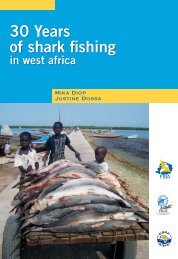Kyne & Simpfendorfer.. - Shark Specialist Group
Kyne & Simpfendorfer.. - Shark Specialist Group
Kyne & Simpfendorfer.. - Shark Specialist Group
You also want an ePaper? Increase the reach of your titles
YUMPU automatically turns print PDFs into web optimized ePapers that Google loves.
SEGREGATION, MOVEMENT AND MIGRATION PATTERNS OF DEEPWATER<br />
CHONDRICHTHYANS<br />
Deepwater chondrichthyans are often segregated bathymetrically by size, sex or maturity<br />
stage. Segregation has been demonstrated by changes in the catch composition with depth,<br />
including for such species as the New Zealand lanternshark Etmopterus baxteri, the black<br />
dogfish Centroscyllium fabricii, the great lanternshark E. princeps, the roughskin dogfish<br />
Centroscymnus owstoni, the Portuguese dogfish C. coelolepis and the spotted ratfish<br />
Hydrolagus colliei (Yano and Tanaka 1988, Wetherbee 1996, Jakobsdóttir 2001, Didier and<br />
Rosenberger 2002). Several studies have noted a lack of gravid females, and it has been<br />
suggested that these may make movements into, or occur in, deeper water (possibly<br />
occupying nursery areas) or that they may be bathypelagic (and thus less susceptible to<br />
capture in benthic fishing gear) (Yano and Tanaka 1988, Wetherbee 1996, Jakobsdóttir 2001).<br />
Nursery areas have not been identified for deepwater shark species.<br />
The short and long-term (including seasonal) movement and migration patterns of deepwater<br />
chondrichthyans are poorly-known. The problems associated with tagging animals caught<br />
from depth and ensuring their survival once returned to the water, along with logistical<br />
constraints, has limited the tagging and tracking of deepwater species. As such tracking<br />
studies of 'deepwater' species has largely been restricted to species which also regularly occur<br />
in the epipelagic zone, at or close to the surface, such as the basking shark Cetorhinus<br />
maximus (discussed briefly under that species' account in the main body of this Section),<br />
sleeper sharks (Somniosus microcephalus and S. pacificus) and the bigeye thresher shark<br />
(Alopias superciliosus). Preliminary tracking of deeper water species has been trialled on the<br />
bluntnose sixgill shark Hexanchus griseus (Carey and Clark 1995), the needle dogfish<br />
Centrophorus acus (Yano and Tanaka 1986) and the Portuguese dogfish Centroscymnus<br />
coelolepis (Bagley et al. 1994).<br />
A number of deepwater squaloid sharks, particularly small pelagic species in the family<br />
Dalatiidae, are vertical migrators. These sharks undertake daily migrations from deep water<br />
towards to the surface at night, returning to depth during the day. Daily vertical movements<br />
may be in excess of 3000m (Compagno in prep. a) and these appear to be linked to the diel<br />
migrations of their prey. Hulbert et al. (2006) showed that diel vertical migrations in S.<br />
pacificus occurred only 25% of the time (i.e. 177 out of 726 days) and as such movement<br />
patterns are more complex than daily repeated vertical movements. <strong>Shark</strong>s were seen to also<br />
undertake 'systematic vertical oscillations' ('methodical ascents and descents with little pause<br />
in transition') and 'irregular vertical movements' ('small-amplitude movements with random<br />
frequency') with the most time spent at depths of 150-450m (Hulbert et al. 2006).<br />
Diel vertical migration also occurs in the bignose shark Carcharhinus altimus. Anderson and<br />
Stevens (1996) reviewed catch records of the poorly-known species determining that the<br />
sharks occupy epibenthic waters at depths of 90–500m during the day, moving either into<br />
shallower water or upwards into the epipelagic zone at night. Telemetry studies employing<br />
acoustic tags (short-term) and pop-up satellite archival tags (long-term) of another vertical<br />
migrator, A. superciliosus, has revealed consistent diel movement patterns with the species<br />
occurring at depth during the day (generally 200–500m, but with dives to 732m) and moving<br />
up in the water column to occupy depths of 10–130m by night (Nakano et al. 2003, Weng and<br />
Block 2004).<br />
Bagley et al. (1994) used acoustic transmitters imbedded in baits employed at 1517–1650m to<br />
briefly track three C. coelolepis, the deepest tracked chondrichthyans. All sharks moved<br />
outside the range of the recording equipment (500m) within 6 hours of bait deployment and<br />
Bagley et al. (1994) suggested that this indicated no site fidelity. A single C. acus acoustically<br />
tracked for nearly 21 hours in Japan generally swam parallel to the 500m depth contour,<br />
mostly remaining close to the seafloor although making some vertical movements to between<br />
98
















